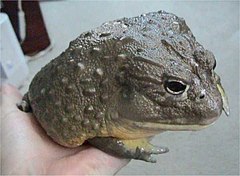| Pyxicephalus[1] | |||
| Tschudi, 1838[2] | |||
 Przedstawiciel rodzaju – buczek południowoafrykański (P. adspersus) | |||
| Systematyka | |||
| Domena | |||
|---|---|---|---|
| Królestwo | |||
| Typ | |||
| Podtyp | |||
| Gromada | |||
| Rząd | |||
| Rodzina | |||
| Podrodzina | |||
| Rodzaj |
Pyxicephalus | ||
| Typ nomenklatoryczny | |||
|
Pyxicephalus adspersus Tschudi, 1838 | |||
| Synonimy | |||
|
| |||
| Gatunki | |||
| |||
Pyxicephalus – rodzaj płazów bezogonowych z podrodziny Pyxicephalinae w rodzinie Pyxicephalidae.
Zasięg występowania
[edytuj | edytuj kod]Rodzaj obejmuje gatunki występujące w niezalesionych obszarach Czarnej Afryki w pozornie w odizolowanych populacjach[5].
Systematyka
[edytuj | edytuj kod]Etymologia
[edytuj | edytuj kod]- Pyxicephalus: gr. πυξις puxis „pudełko, skrzynka”[6]; κεφαλος -kephalos „-głowy”, od κεφαλη kephalē „głowa”[7].
- Maltzania: Hermann Friedrich Freiherr von Maltzan (1843–1891), niemiecki malakolog i podróżnik[3]. Gatunek typowy: Maltzania bufonia Boettger, 1881 (= Pyxicephalus edulis Peters, 1854).
- Phrynopsis: gr. φρυνη phrunē, φρυνης phrunēs „ropucha”[8]; οψις opsis, οψεως opseōs „wygląd, oblicze, twarz”[9]. Gatunek typowy: Phrynopsis boulengerii Pfeffer, 1893 (= Pyxicephalus edulis Peters, 1854).
Podział systematyczny
[edytuj | edytuj kod]Do rodzaju należą następujące gatunki[5]:
- Pyxicephalus adspersus Tschudi, 1838 – buczek południowoafrykański[10]
- Pyxicephalus angusticeps Parry, 1982
- Pyxicephalus beytelli Du Preez, Netherlands, Rödel & Channing, 2024
- Pyxicephalus edulis Peters, 1854
- Pyxicephalus obbianus Calabresi, 1927
Przypisy
[edytuj | edytuj kod]- ↑ Pyxicephalus, [w:] Integrated Taxonomic Information System (ang.).
- ↑ J.J. von Tschudi: Classification der Batrachier mit Berücksichtigung der fossilen Thiere dieser Abtheilung der Reptilien. Neuchâtel: Petitpierre, 1838, s. 46. (niem.).
- ↑ a b O. Boettger. Aufzählung der von Frhrn. H. und Frfr. A. von Maltzan im Winter 1880/81 am Cap Verde in Senegambien gesammelten Kriechthiere. „Abhandlungen der Senckenbergischen Naturforschenden Gesellschaft”. 12, s. 417, 1881. (niem.).
- ↑ G.J. Pfeffer. Ostafrikanische Reptilien und Amphibien, gesammelt von Herrn Dr. F. Stuhlmann im Jahre 1888 und 1889. „Jahrbuch der Hamburgischen Wissenschaftlichen Anstalten”. 10 (Erste Hälfte. 1892), s. 101, 1893. (niem.).
- ↑ a b D. Frost: Pyxicephalus Tschudi, 1838. [w:] Amphibian Species of the World 6.2, an Online Reference [on-line]. American Museum of Natural History. [dostęp 2024-06-15]. (ang.).
- ↑ Jaeger 1944 ↓, s. 191.
- ↑ Jaeger 1944 ↓, s. 44.
- ↑ Jaeger 1944 ↓, s. 173.
- ↑ Jaeger 1944 ↓, s. 155.
- ↑ Praca zbiorowa: Zwierzęta: encyklopedia ilustrowana. Warszawa: Wydawnictwo Naukowe PWN, 2005, s. 445. ISBN 83-01-14344-4.
Bibliografia
[edytuj | edytuj kod]- Edmund C. Jaeger, Source-book of biological names and terms, wyd. 1, Springfield: Charles C. Thomas, 1944, s. 1–256, OCLC 637083062 (ang.).









